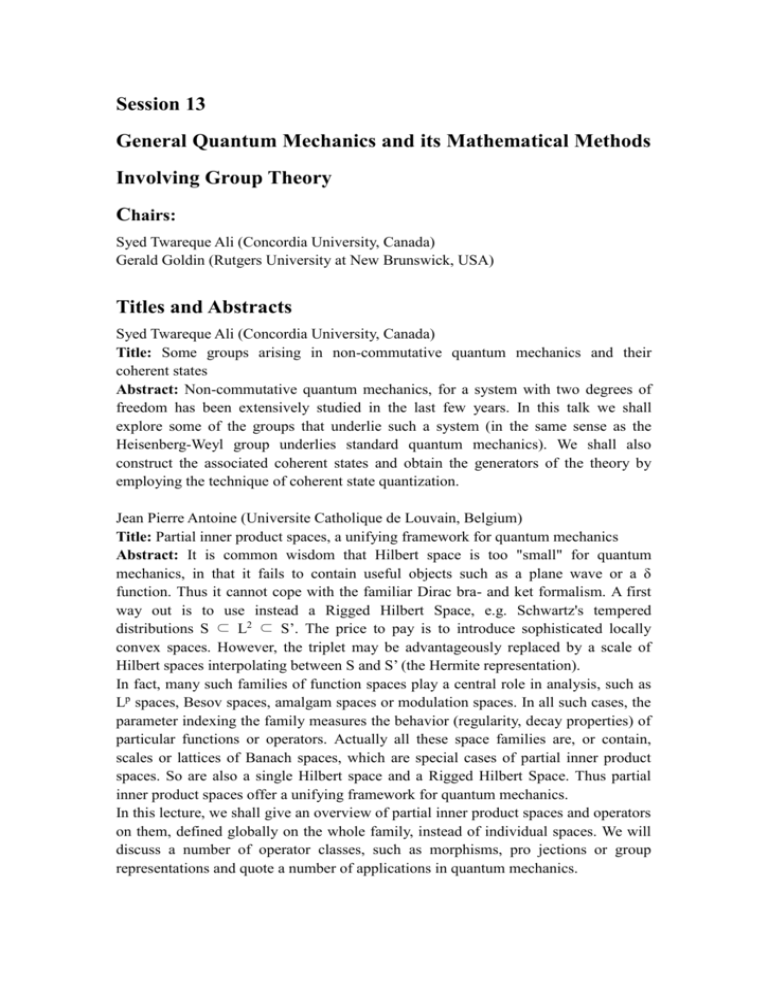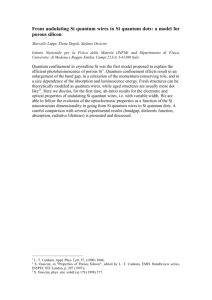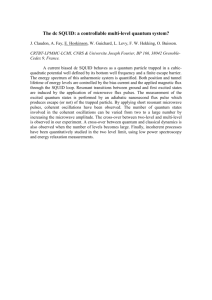Titles and Abstracts
advertisement

Session 13
General Quantum Mechanics and its Mathematical Methods
Involving Group Theory
Chairs:
Syed Twareque Ali (Concordia University, Canada)
Gerald Goldin (Rutgers University at New Brunswick, USA)
Titles and Abstracts
Syed Twareque Ali (Concordia University, Canada)
Title: Some groups arising in non-commutative quantum mechanics and their
coherent states
Abstract: Non-commutative quantum mechanics, for a system with two degrees of
freedom has been extensively studied in the last few years. In this talk we shall
explore some of the groups that underlie such a system (in the same sense as the
Heisenberg-Weyl group underlies standard quantum mechanics). We shall also
construct the associated coherent states and obtain the generators of the theory by
employing the technique of coherent state quantization.
Jean Pierre Antoine (Universite Catholique de Louvain, Belgium)
Title: Partial inner product spaces, a unifying framework for quantum mechanics
Abstract: It is common wisdom that Hilbert space is too "small" for quantum
mechanics, in that it fails to contain useful objects such as a plane wave or a δ
function. Thus it cannot cope with the familiar Dirac bra- and ket formalism. A first
way out is to use instead a Rigged Hilbert Space, e.g. Schwartz's tempered
distributions S ⊂ L2 ⊂ S’. The price to pay is to introduce sophisticated locally
convex spaces. However, the triplet may be advantageously replaced by a scale of
Hilbert spaces interpolating between S and S’ (the Hermite representation).
In fact, many such families of function spaces play a central role in analysis, such as
Lp spaces, Besov spaces, amalgam spaces or modulation spaces. In all such cases, the
parameter indexing the family measures the behavior (regularity, decay properties) of
particular functions or operators. Actually all these space families are, or contain,
scales or lattices of Banach spaces, which are special cases of partial inner product
spaces. So are also a single Hilbert space and a Rigged Hilbert Space. Thus partial
inner product spaces offer a unifying framework for quantum mechanics.
In this lecture, we shall give an overview of partial inner product spaces and operators
on them, defined globally on the whole family, instead of individual spaces. We will
discuss a number of operator classes, such as morphisms, pro jections or group
representations and quote a number of applications in quantum mechanics.
Joseph Ben Geloun (Perimeter Institute for Theoretical Physics, Canada)
Title: Enhanced quantization on the circle
Abstract: The quantization scheme introduced by Klauder in [arXiv:1204.2870] is
applied to a particle on a circle. We find that the quantum action functional restricted
to appropriate coherent states can be expressed as the classical action plus
$\hbar$-corrections. Quantum Hamiltonians endowed with a general periodic and
particular singular potential ones will be discussed.
Arno Bohm (University of Texas at Austin, USA)
Title: Groups or Semi-groups for the Dynamical Equations of Quantum Theory
Abstract: Experiments on quantum systems are usually divided into preparation of a
state and registration of an observables in that state. The traditional mathematical
methods of quantum theory (Hilbert space or Schwartz space of distribution theory),
do not provide a possibility to distinguish mathematically between observables and
states. But in the experimental set-up, one clearly distinguishes between the
preparation of a state and the registration of an observable in the state, and a state
must be prepared first by a time t0 before an observable can be measured in it. This
suggests time asymmetric boundary conditions for the dynamical equations of
quantum theory. Such boundary conditions have been provided by Hardy spaces in
the Lax-Phillips theory for electromagnetic and acoustic scattering phenomena. A
quantum theory that unifies decaying states and scattering resonances also requires
Hardy space boundary conditions. It leads to time asymmetric semi-group evolutions
and a quantum mechanical arrow of time.
Paul Busch (University of York, UK)
Title: Quantum Measurements Constrained by Symmetries
Abstract: The Wigner-Araki-Yanase (WAY) theorem states a remarkable limitation to
quantum mechanical measurements in the presence of additive conserved quantities.
Discovered by Wigner in 1952, this limitation is known to induce constraints on the
control of individual quantum systems in the context of information processing. It is
therefore important to understand the precise conditions and scope of the WAY
theorem. Here I elucidate its crucial assumptions, briefly review some generalizations,
and show how a particular extension can be obtained by a simple modification of the
original proofs. I also describe the evolution of the WAY theorem from a strict no-go
verdict for certain, highly idealized, precise measurements into a quantitative
constraint on the accuracy and approximate repeatability of imprecise measurements.
Eric Alvarez Galapon (University of the Philippines, Philippines)
Title: Time in Quantum Mechanics: Recent Progress in Theoretical and Experimental
Fronts
Abstract: We review recent progress in theoretical and experimental fronts in
quantum time problem. We focus on the theory of quantum first time of arrival and its
predictions, in particular, in quantum wave-packet size effects to the classical time of
flight and in quantum barrier traversal time. Recent experiments in quantum tunneling
time will be highlighted, and their results compared to the predictions of the theory:
Experiments with helium ionization give zero tunneling time within experimental
limits and time of arrival theory predicts exactly zero tunneling time.
François Gay-Balmaz (Ecole Normale Superieure de Paris, France)
Title: Equivalent theories of liquid crystal dynamics
Abstract: There are two competing descriptions of nematic liquid crystal dynamics:
the Ericksen-Leslie director theory and the Eringen micropolar approach. Up to this
day, these two descriptions have remained distinct in spite of several attempts to show
that the micropolar theory comprises the director theory. In this talk we will show that
this is the case by using Lie group symmetry reduction techniques and introducing a
new system that is equivalent to the Ericksen-Leslie equations and includes
disclination dynamics. More precisely, we will show how these systems can be seen
as Euler-Poincare equations on a semidirect product involving the diffeomorphism
group and the gauge group of the theory, and how this geometric approach can be
used to prove that the micropolar theory of liquid crystal comprises the well-known
Ericksen-Leslie theory, by applying two symmetry reduction processes. The resulting
equations of motion are verified to be completely equivalent, although one of the two
offers the possibility of accounting for orientational defects. After applying these two
approaches to the ordered micropolar theory of Lhuiller and Rey, all the results are
eventually extended to flowing complex fluids, such as nematic liquid crystals.
Gerald Goldin (Rutgers University at New Brunswick, USA)
Title: Nonlinear electrodyamics and conformal symmetry
Abstract: I shall describe some explorations of nonlinear variations of electromagnetism respecting conformal symmetry, based on joint work with Steven Duplij
and Vladimir Shtelen.
Katarzyna Gorska (Polish Academy of Sciences, Poland)
Title: Exact and explicit forms of Levy stable distribution
Abstract: We briefly recall the origin, history and some physical applications
(fractional Fokker-Planck equation) of Levy stable probability distributions. We report
on recent findings of exact and explicit expressions for one-sided (0 < α < 1) and
two-sided (1 < α ≤ 2) Levy stable densities g α (x), of index α for all α =l/k,
with k and l positive integers. We shall exemplify analytically and graphically several
examples of known, and an infinite ensemble of new formulae for such distributions.
We observe that the one- and two-sided Levy density can be obtained via so-called
Levy2 transform L(2) α , which satisfy the semigroup properties.
[1] K. A. Penson and K. Gorska, Phys. Rev. Lett. 105, 210604 (2010).
[2] K. Gorska, K. A. Penson, Phys. Rev. E 83, 061125 (2011).
[3] K. Gorska, K. A. Penson, D. Babusci, G. Dattoli, G. H. E. Duchamp, Phys. Rev. E
85, 031138 (2012).
[4] K. Gorska and K. A. Penson, J. Math. Phys. (2012), arXiv: 1202.1789.
Norbert Hounkonnou (University of Abomey-Calavi, Benin)
Title: On generalized oscillator algebras and their associated coherent states
Abstract: A unified method of calculating structure functions from commutation
relations of deformed single-mode oscillator algebras is presented. A natural approach
to building coherent states associated to deformed algebras is then deduced. Known
deformed algebras are given as illustration and such mathematical properties as
continuity in the label, normalizability and resolution of the identity of their
corresponding coherent states are discussed.
Mourad Ismail (King Saud University, Saudi Arabia and University of Central Florida,
USA)
Title: The J-matrix method and some of its applications
Abstract: Given an operator L acting on a function space, the J-matrix method
consists of finding a sequence {f(x;n)} of functions such that the operator L acts
tridiagonally on {f(x;n)}. Once such a tridiagonalization is obtained, a number of
characteristics of the operator L can be obtained. In particular, information on
eigenvalues and eigenfunctions, bound states, spectral decompositions, etc. can be
obtained in this way. We discuss the general set-up and next two examples in detail.
This approach uses orthogonal polynomials.
Teiko Heinosaari (University of Turku, Finland)
Title: Informationally complete quantum observables and joint measurements
Abstract: A quantum observable is called informationally complete if it separates all
states. It is possible to implement this kind of observable as a joint measurement of
simpler observables. Implications to the structure of symmetric informationally
complete observables will be discussed.
Pekka Lahti (University of Turku, Finland)
Title: Deriving quantum mechanics using a generalized Wigner theorem and a
theorem of Solér (A joint work with Gianni Cassinelli.)
Abstract: We outline a program for the axiomatic reconstruction of quantum
mechanics that combines the precise use of a theorem of M.P. Solér with the idea of
symmetry. We give a generalized version of the Wigner theorem for symmetry
transformations and show how this result can be used in conjunction with Solér's
theorem. We also pinpoint an essential mathematical assumption which still seems to
lack an operational justification.
Tudor Ratiu (Ecole Polytechnique Federale de Lausanne, Switzerland)
Title: Standard and higher order Lagragian reduction
Abstract: We begin by a presentation of the Euler-Lagrange operator which naturally
leads to higher order tangent bundles. Then we review Euler-Poincare reduction and
the associated operator obtained by reduction. As an example, affine Euler-Poincare
reduction will be presented. After reviewing the geometric setting for continuum
mechanics the example of the heavy top will be discussed and both reduction to the
convective and spatial representation will be carried out. The same program is then
presented for fixed boundary barotropic fluids and elasticity. Finally the
Lagrange-Poincare operator will be discussed in detail and both the
Lagrange-Poincare and Hamilton-Poincare equations will be presented. The reduced
Poisson magnetic structure will be presented and the example of Wong's equations
will be discussed. The talk closes with a detailed presentation of the higher order
tangent bundles and their quotients motivated by the study of splines and, in the
presence of symmetries, reduction is carried out. The higher order Lagrange-Poincare
and the Ostrogradsky-Hamilton-Poincare equations will be presented.
Dieter Schuch (J.W. Goethe-Universitat Frankfurt/M, Germany)
Title: On Generalized Coherent States and Complex Riccati Equations
Abstract: Based on Gaussian wave packet solutions of the time-dependent
Schrödinger equation, a generalization of the conventional creation and annihilation
operators and the corresponding coherent states can be obtained. This generalization
includes systems where also the width of the coherent states is time-dependent as they
occur for harmonic oscillators with time-dependent frequency or systems in contact
with a dissipative environment. The key point is the replacement of the frequency 0
that occurs in the usual definition of the creation/annihilation operator by a complex
time-dependent function that fulfils a nonlinear Riccati equation. This equation and its
solutions depend on the system under consideration and on the (complex) initial
conditions. Formal similarities also exist with general superpotentials leading to
isospectral potentials in supersymmetric quantum mechanics.
Mauro Spera (Universita' di Verona, Italy)
Title: Some applications of geometric quantization
Abstract: In the present talk we give a condensed survey of some recent applications
of geometric quantization mostly related to theta function theory (Landau levels,
quantum monodromy), vortex and anyon theory (Laughlin wave functions). The
relationship with geometric quantum mechanics (wherein the basic theory is recast in
(projective) geometric form) will be discussed as well. Finally, we shall outline a
differential geometric approach to the theory of abelian n-gerbes equipped with
multilayered connections (which generalise line bundles with connections), based on
transgression ideas, and provide explicit examples with physical significance.
Eyal Subag (Technion-Israel Institute of Technology, Israel)
Title: Contraction of so(n) representations via the Gelfand-Tsetlin bases
Abstract: We realize any skew-Hermitian integrable representation of iso(n-1) as a
contraction of skew-Hermitian integrable representations of so(n). We show that any
representation of iso(n-1) is a natural direct limit of so(n) representations. Our
construction relies on the existence of Gelfand-Tsetlin bases for so(n) representations.
Franciszek Hugon Szafraniec (Jagiellonian University, Poland)
Title: Spacial properties of commutation relations
Abstract: Starting from my paper Subnormality in the quantum harmonic oscillator,
Commun. Math. Phys., 210(2000), 323-334, I will examine commutation relations
from a mathematician's point of view. Besides making precise their meaning, basing
on the oscillator like cases, I will explain how replacing "second order" assumptions
by those of "first order" lead to existence of the vacuum.
Apostol Vourdas (University of Bradford, UK)
Title: Partial order and divisor topology in a set of finite quantum systems
Abstract: A 'whole-part' theory is developed for a set of finite quantum systems with
variables in Z(n). The partial order 'subsystem' is defined, by embedding various
attributes of the system (quantum states, density matrices, etc) into their counterparts
in the supersystem (for m|n). The compatibility of these embeddings is studied. The
concept of ubiquity is introduced for quantities which fit with this structure. It is
shown that various entropic quantities are ubiquitous. The sets of various quantities
become T0-topological spaces with the divisor topology, which encapsulates
fundamental physical properties. By adding `top elements' we convert these sets into
directed-complete partial orders. The continuity of various maps among these sets is
studied.
Hishamuddin Zainuddin (Universiti Putra, Malaysia)
Title: Role of Commutator Subgroup of the Modular Group in System of a Particle on
Punctured Torus
Abstract: We consider a system of a particle moving on a punctured torus. The
punctured torus can be realised by the quotient space of the upper half plane $H$ by
the commutator subgroup $\Gamma'$ of the modular group. Noting that the
fundamental group of the surface is $\Gamma'$, the group generators and the cusp
stabiliser play the role of representing the winding modes around the cycles of the
torus and its cusp. We also discuss the construction of quantum bound states on this
surface using $\Gamma'$-automorphic forms and highlight the group and
number-theoretic relations used for the wavefunctions. Finally we will make some
remarks
on
the
sequence
$\Gamma'\rightarrow\Gamma\rightarrow\mathbb{C}^\ast$
and
its
role
in
constructing wavefunctions. This is a joint work with Chan Kar Tim.





